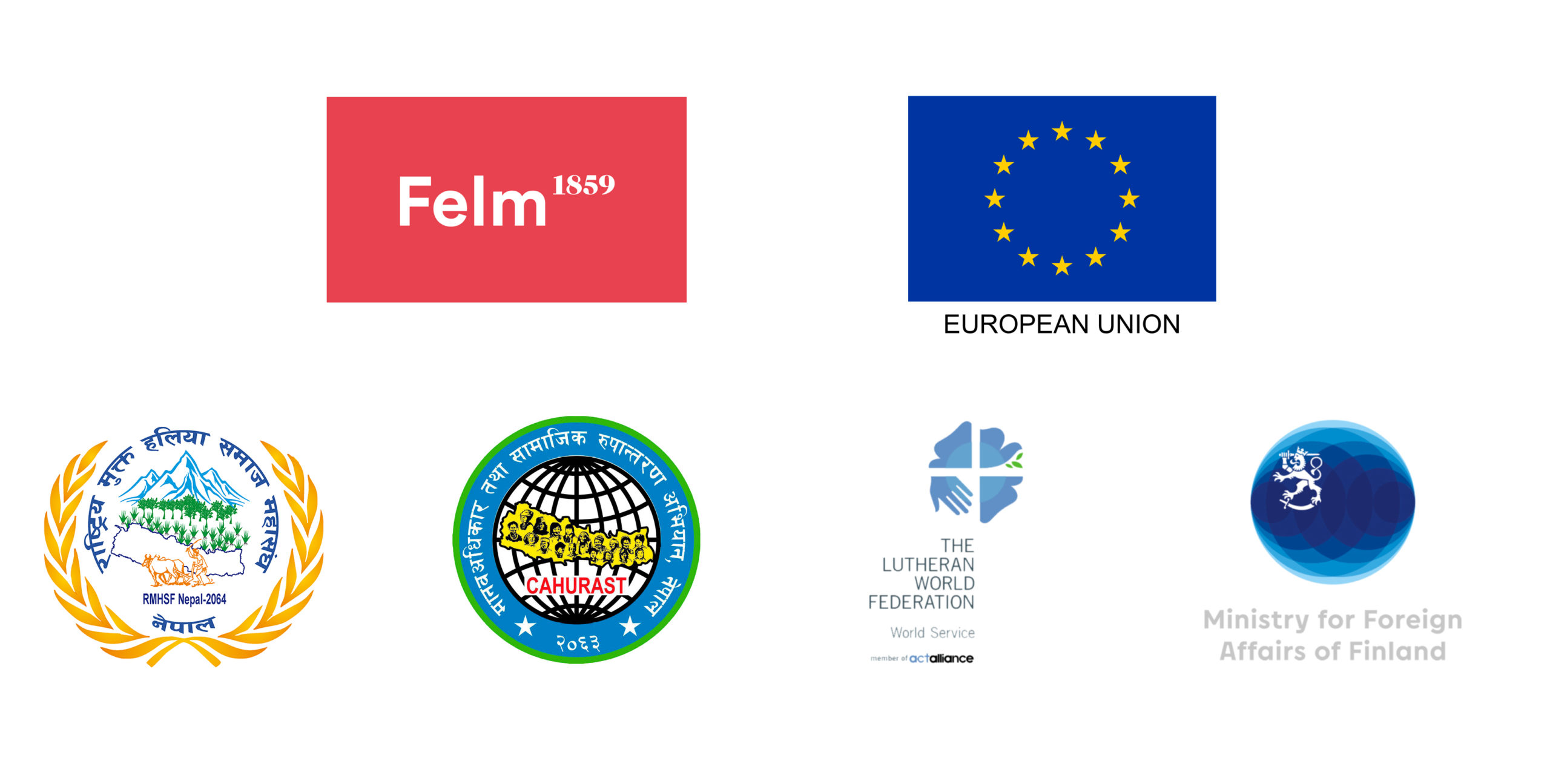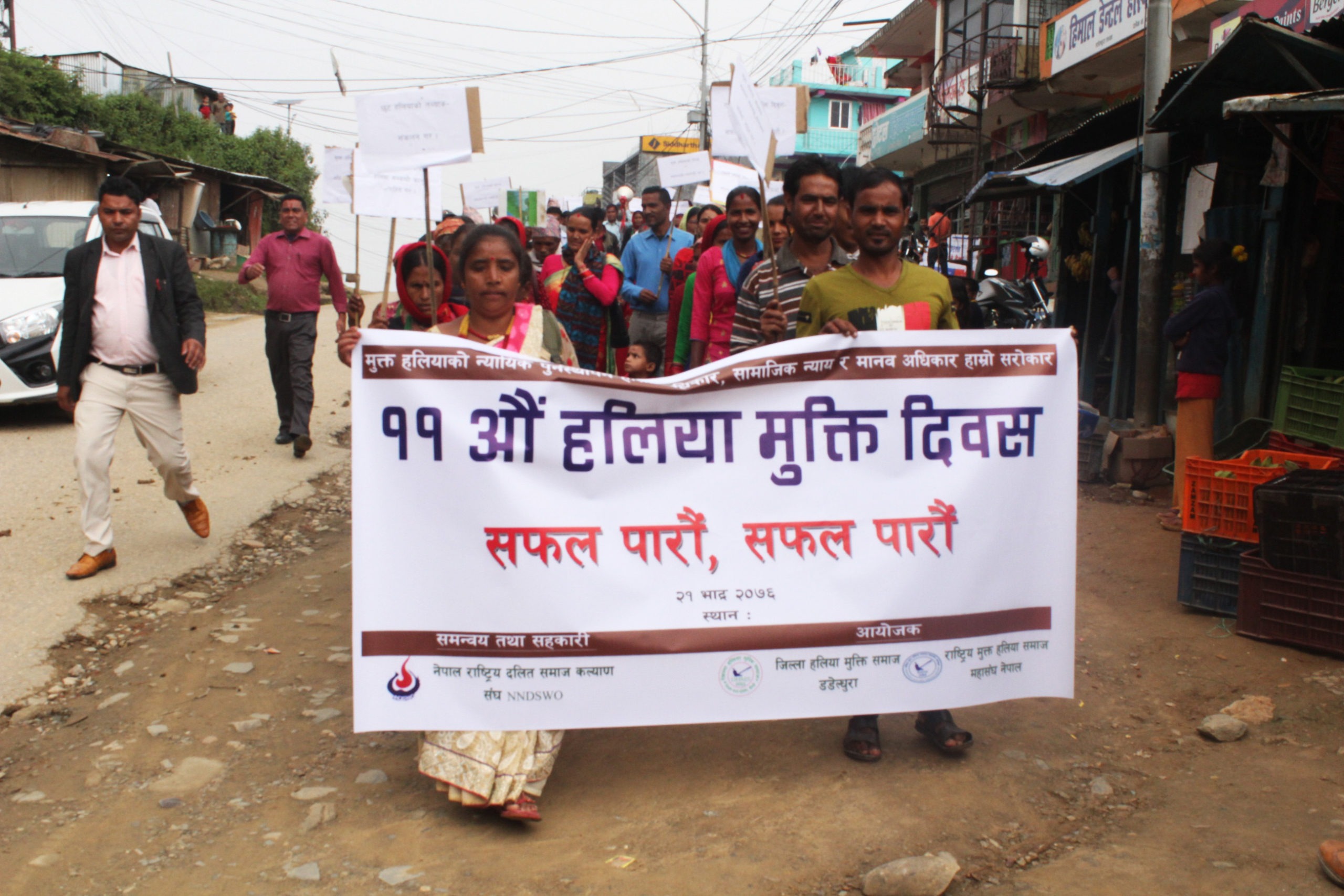(Below in Nepali)
6th of September is celebrated as the Freed Haliya Day in Nepal. But not all people know who these freed Haliyas are. Why were they freed in the first place? And why is this day important?
Haliya literally means “one who tills lands”. Traditionally, they were enslaved within a system of bonded labour and forced by their landlords to do hard labor work. The Haliya system is viewed as a modern form of slavery, an exploitative system of agrarian bonded labour prevalent in the Western hill districts of Nepal.
It is not known when the Haliya system exactly started. However, it is believed that Nepal’s system of caste-based discrimination is the main factor leading to the creation and continuation of the system even until the 21st century. About 97 percent of Haliyas are from the so-called lower caste Dalits groups, the untouchable caste.
Extreme poverty and debt have relegated many Dalits to Haliya status. In majority of the cases, the enslaved Haliyas typically have no direct association with any of the debts, but the dues are accumulated by their ancestors over many generations. Such debts are often so excessive that even after working for their entire lifetimes, Haliyas remain unable to generate enough income, as they are not paid a wage but instead are provided just food.
With very limited financial sources, especially during times of hardship, Haliyas have often had to borrow even more money. This adds additional interest to their debts, condemning future generations of Haliyas to the same fate. Simply, Haliyas were the people forced to work as tillers for some rich households, mostly because they or their forefathers owed something to the houses.
System abolished 12 years ago
On the 6thof September 2008, the Government of Nepal announced the abolishment of the Haliya system and declared all the 12 districts where Haliyas lived as freed Haliya zones. From then, a day is celebrated as the Haliya Emancipation Day – freed Haliya Day.
The very first freed Haliya Day was celebrated with the joy for the Haliyas being announced as freed Haliyas. The year then started with a sense of freedom and hope of getting rehabilitation funds from the government for starting a new life. Unfortunately despite a decade after the emancipation of Haliyas, many Haliyas are yet to receive rehabilitation packages (shelter and livelihood opportunities).
Aarati Sunar, a freed Haliya woman, says: “It is a sense of relief that now we are freed from being Haliya, but we are still living in poverty, depending on a daily wage and with a shortage of food even for a day. Higher caste people refuse to provide loans for Haliyas in need, saying: Now you are freed from Haliya system, why do you need money? The other communities view Haliyas still in a different way, we are discriminated for being Haliyas”.
She continues, “I hope that the Haliya Day can make an effort in bringing a change for the new generations, so that they would not be discriminated by other communities and labelled as Haliyas”.
More work needed for the rights of Haliyas
A high-level committee under the Convenorship of Minister of Land Management, Cooperatives and Poverty Alleviation to rehabilitate freed Haliyas initially listed 19,059 families at first. Later, they listed to have only 16,953 Haliya families in need of rehabilitation. However, freed Haliya leaders claim that there are around 25,000 freed Haliyas who are still unregistered.
These discrepancies in the data have caused difficulties in providing timely rehabilitation packages and Haliya cards for freed Haliyas. Lack of proper legal mechanisms has left the situation of Haliyas weak. On one side, a just rehabilitation process hasn’t been fulfilled, and on the other side, landowners have stopped lending money to Haliyas in emergency. Haliyas have been denied a life with dignity.
So, the freed Haliya day has been celebrated annually with different motives – as a protest for not fixing the Haliyas issues, as a day to make the Haliyas more aware about their rights, and to make the authorities responsible for fulfilling the demands and so on. Now, the Freed Haliya Day, has transformed into a day for showing that Haliya rights still need to be defended.
Bharat Sarki, Chair of Mukta Haliya Federation, Dadeldhura and a freed Haliya, says that to some extent, the liberation has proven to be a curse for Haliyas. They still have to plough fields of landlords but unlike in the past, now they don’t get the support that they were used to get as a part of the tradition of Haliyas. Corona outbreak has even worsened Haliyas’ situation, with more people living in greater poverty.
It is crucial to continue celebrating the day, in order to grab the attention of everyone for a permanent change to happen. This year 2020 is celebrated as 12th freed Haliya Day, with a major objective to raise accountability for addressing the current Haliya issues and raise awareness amongst Haliyas about their own rights.
Let’s not let the emancipation of freed Haliyas be a curse, lets’ build a day for freedom!
Written by Bishnu Pukar Shrestha, Chairman, Sarala Maharjan, Program Manager, and Christina Nakarmi, Project Coordinator of Campaign for Human Rights and Social Transformation Nepal (CAHURAST).
This blog has been produced with the financial assistance of the European Union. The contents of this text are the sole responsibility of the project partners and can in no way be taken to reflect the views of the European Union.
मुक्त हलिया दिवस : पूर्ण स्वतन्त्रताको दिन निर्माण गरौं
आज सेप्टेम्बर ६ का दिन नेपालमा मुक्त हलिया दिवस मनाइन्छ। तर सबैलाई मुक्त हलियाहरू को हुन्?, तिनीहरूलाई पहिला किन मुक्त गरियो? र यो दिन किन महत्त्वपूर्ण छ? भन्ने कुरा थाहा छैन।
हलियाको शाब्दिक अर्थ “जमिन जोत्ने मानिस” भन्ने हुन्छ | प्राचीन रूपमा, तिनीहरु बँधुवा प्रथाभित्र दास बनाईएका थिए र जमिन्दारहरुले कडा श्रम गर्न बाध्य पारिएका थिए | हलिया प्रथालाई आधुनिक दासत्वको रूपमा हेरिन्छ | कृषि बँधुवा को एउटा यस्तो शोषणकारी प्रथा जुन अझै पनि नेपालको पश्चिमी पहाडी जिल्लाहरुमा कायम रहेको पाईन्छ |
हलिया प्रथा ठ्याक्कै कहिलेबाट सुरू भयो भन्ने थाहा हुन सकेको छैन । यद्यपि यो विश्वास गरिन्छ कि यो प्रथाको प्रचलन एक्काईसौ शताब्दीसम्म पनि निरन्तर हुनुको प्रमुख कारण नेपालमा रहेको जातीय भेदभावको व्यवस्था हो। तसर्थ जातीय विभेदको सुरुवात संगै यो प्रथा सुरु भएको अनुमान गर्न सकिन्छ | लगभग ९७ प्रतिशत हलिया, अछुत तथा तल्लो जात मानिने दलित समुदायबाट रहेको छ ।
धेरै दलितहरूलाई चरम गरिबी र ऋणले हलियाको स्थितिमा पुर्याएको पाईन्छ। प्रायः जसो दास बनाइएका हलियाहरुको ऋणसंग सामान्यतया कुनै प्रत्यक्ष सम्बन्ध देखिदैन, तिनीहरुका पुर्खाहरुले लिएको ऋणको बकौताका कारण पुस्तान्तरण सम्म ऊनीहरु ऋणी बन्न पुगे । त्यस्ता ऋणहरू यति धेरै भए कि हलियाहरुले आफ्नो सम्पूर्ण जीवनकाल काम गरे पनि पर्याप्त मात्रामा आय आर्जन गरि ऋण तिर्न असमर्थ भए, त्यसको एउटा कारण उनीहरूलाई ज्यालाको रूपमा खाद्यान्न मात्रै दिने गरियो।
अर्को तर्फ पुरानो ऋण को अलावा हलियाहरुले आफ्नो न्युन आर्थिक स्रोतका कारण, विशेष गरी पारिवारिक समस्याको समयमा मालिक संग थप ऋण लिन पर्ने हुन्छ। यसले उनीहरूले लिएको ऋणमा थप ब्याज बढाउँदछ र भावी पुस्तालाई समेत उस्तै भविष्य दिलाउँछ। सरल रूपमा हलियाहरू भनेका आफु या आफ्नो बाबु बाजे ले घर चलाउन केहि ऋण लिए बापत ऊनीहरुको जमिन जोत्न बाध्य बनाएका व्यक्ति हुन् |
१२ बर्ष अघि उन्मूलन भएको प्रथा
नेपाल सरकारले सेप्टेम्बर ६, २००८ मा हलिया प्रथाको उन्मूलन गर्ने घोषणा गर्यो र हलियाहरु रहेका १२ जिल्लाहरुलाई मुक्त हलिया क्षेत्रका रूपमा घोषित गर्यो। सोहि दिनदेखि, मुक्त हलिया दिवस मनाईएको हो।
हलियाहरुलाई मुक्त हलिया घोषणा गरेको कारण पहिलो मुक्त हलिया दिवस खुशीयालीका साथ मनाइएको थियो। सो वर्ष स्वतन्त्रताको भावना र नयाँ जीवन सुरु गर्न सरकारबाट पुनःस्थापना कोष प्राप्त गर्ने आशाको साथ शुरू भयो। दुर्भाग्यवस, हलियाहरु मुक्त भएको एक दशक पछि पनि धेरै हलियाहरूले पुन: स्थापना प्याकेज (आश्रय र आजीविका अवसर) पाएका छैनन्।
आरती सुनार एउटी मुक्त हलिया महिला भन्छिन्: “यो राहतको कुरा हो कि अब हामी हलिया हुनबाट मुक्त भएका छौं, तर हामी अझै पनि दैनिक ज्यालामा निर्भर भई गरिबीमा बाँचिरहेका छौं, र एक दिनको छाक टार्न पनि अभाव छ। माथिल्लो जातका मानिसहरूले हलियालाई आवश्यक परेको बेला ऋण दिन अस्वीकार गर्दै भन्छन्: अब तिमीहरु हलिया प्रथाबाट मुक्त भईसकेका छौ, पैसा किन चाहियो र ? अन्य समुदायले हलियालाई अझै पनि फरक दृष्टिकोणले हेर्छन्, हामीलाई हलिया भनेर भेदभाव गरिएको छ।
उनी थप्छिन्, “मलाई आशा छ कि हलिया दिवसले नयाँ पुस्ताका लागि परिवर्तन ल्याउन प्रयास गर्नेछ, ताकि उनीहरूलाई अन्य समुदायले भेदभाव नगरी हलिया भन्ने संज्ञा नलगाईयोस्।”
हलियाको अधिकारका लागि अझै सशक्त भएर अघि बढ्नुपर्ने आवश्यकता छ
मुक्त हलियालाई पुनःस्थापना गर्न भूमि व्यवस्था, सहकारी र गरिबी निवारण मन्त्रालयको संयोजकत्वमा उच्च स्तरीय समितिले सुरुमा १९०५९ परिवारलाई सुरुमा सूचीबद्ध गर्यो। पछि, केवल १६९५३ हलिया परिवारलाई पुनःस्थापनाको आवश्यकता भएको सूचीकृत गरे। यद्यपि, मुक्त हलिया नेताहरूको दावी छ कि २५००० भन्दा बढी मुक्त हलिया अझै पनि दर्ता गरिएका छैनन् |
तथ्यांकमा रहेका यी भिन्नताहरूका कारण हलियाहरुलाई समयमै पुनःस्थापना प्याकेज र हलिया कार्ड प्रदान गर्न गाह्रो भएको छ। उचित कानुनी संयन्त्रको अभावले हलियाहरुको अवस्था कमजोर बनाएको छ। एका तर्फ, पुनःस्थापना प्रक्रिया पूरा भएको छैन, र अर्को तर्फ, जग्गा धनीहरुले आपतकालमा हलियाहरुलाई ऋण दिन रोकेका छन्। मर्यादापूर्ण जीवन बिताउन हलियाहरु अझै अस्वीकृत भएका छन्।
त्यसकारण मुक्त हलिया दिवस विभिन्न उदेश्यका साथ् मनाउने गरिन्छ| एक त हलियाको मुद्दाहरूको समाधान नभएकोमा विरोधका रुपमा, अर्को हलियालाई उनीहरूको अधिकारको बारेमा बढी सचेत गराउने उदेश्यले र यस्तै अन्य उद्देश्यका साथ मुक्त हलिया दिवस मनाइएको छ। अहिले मुक्त हलिया दिवस अझै पनि हलियाका अधिकारहरूको रक्षा गर्नु जरुरी छ भन्ने देखाउने दिनका रूपमा रुपान्तरित भएको छ।
मुक्त हलिया महासंघ डडेल्धुराका अध्यक्ष तथा मुक्त हलिया भरत सार्की भन्छन् कि एक ढंग ले यो मुक्ति, हलियाका लागि श्राप सावित भएको छ। उनको तर्क छ कि उनीहरूले अझै जमिन्दारहरूको खेत जोत्नुपर्दछ तर विगतमा जस्तो हैसियत प्राप्त हुदैन किनकि तिनीहरुले हलिया परम्परामा मालिक को समर्थन पाउंथे र परम्परागत हिस्साका रूपमा प्रयोग गरिन्थे । कोरोना प्रकोपले हलियाको अवस्थालाई झनै नराम्रो बनाएको छ, तसर्थ धेरै व्यक्तिहरू झन् गरीबीमा बाच्न विवस छन्।
स्थायी परिवर्तनका लागि सबै सरोकारवालाको ध्यानाकर्षण गर्न यो दिवस मनाउन अत्यन्तै जरुरी छ। हलिया सम्बन्धी मुद्दाहरूको सम्बोधनका लागि उत्तरदायित्व बढाउने र हलियाको जागरूकतालाई बढावा दिने उदेश्यका साथ १२ औं मुक्त हलिया दिवस २०२० मनाइदैछ।
मुक्त हलियाको उन्मूलनलाई श्राप हुन नदेऔऊ, पूर्ण स्वतन्त्रताको दिन निर्माण गरौं!
यो ब्लग यूरोपेली संघको आर्थिक सहयोगमा बनाईएको हो। यस पाठका सामग्रीहरू परियोजना साझेदारहरूको एकमात्र उत्तरदायित्व हो र कुनै पनि हिसाबले यूरोपियन युनियनको विचार प्रतिबिम्बित गर्दैन ।


